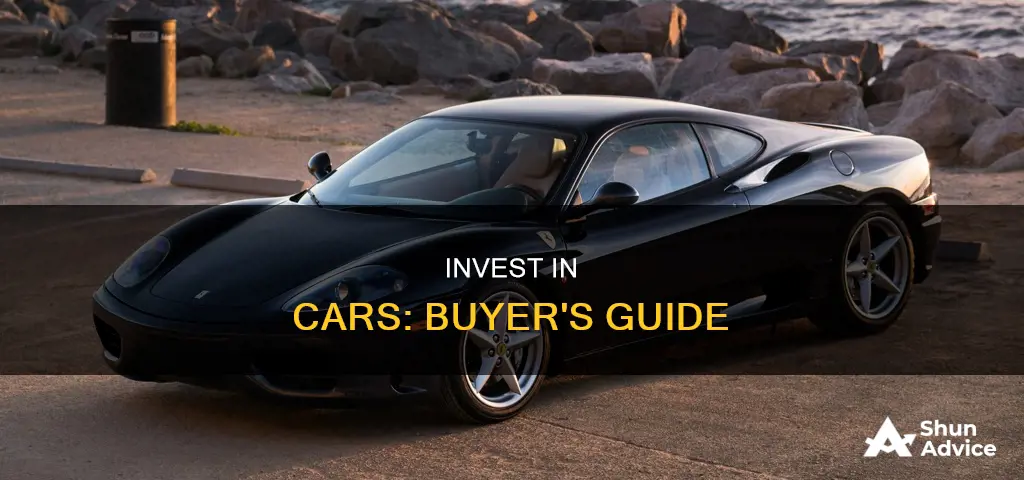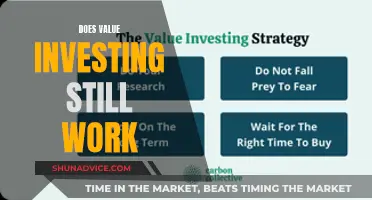
Investing in cars is a niche market for connoisseurs, the well-to-do, and high-net-worth individuals who can afford the costs of entry. It is generally the domain of the collector, with classic cars being the most common type of car purchased for investment purposes. While new cars can lose up to a third of their value after leaving the lot, classic cars gain value over time due to rarity, performance, or special attributes. The most significant factor in a car's investment value is its original condition, with cars in their original state being worth double or triple their inauthentic counterparts.
There are several types of collectors' cars. Modern classics refer to cars built up to the year 2000, while antique cars refer to those manufactured before 1975. Vintage cars are those built before 1930. Cars with historical importance, racing history, or association with a respected designer or celebrity owner can also become collectibles.
Investing in cars is not without its risks. The prices of popular collector cars can start in the low six figures and rise to the millions. There are also significant carrying costs, including maintenance, preservation, insurance, parts, and labour. Additionally, the prospect of inspecting a vehicle for aesthetics, mechanics, and authenticity is a complex and nuanced undertaking that can require years of study and experience.
Despite the risks, cars can be a unique diversifier for an investment portfolio, as their value is correlated with but not perfectly corresponding to equity returns.
| Characteristics | Values |
|---|---|
| Type of Investment | Ownership investment |
| Investment Vehicle | Collectibles |
| Investment Returns | Modest returns, not passive |
| Investment Risk | High-risk |
| Investor Profile | Automotive enthusiast, connoisseurs, well-to-do, high-net-worth individuals |
| Investment Cost | Low six figures to millions of dollars |
| Carrying Costs | Maintenance, preservation, insurance, parts, labour, capital gains tax |
| Investment Strategy | Diversification, long-term |
| Investment Research | Study history, specs, model types, appreciation potential |
| Investment Purchase | Auction houses, online auction sites, local periodicals, dealerships |
What You'll Learn
- Classic cars are a niche market for connoisseurs and high-net-worth individuals
- Classic cars are high-maintenance and require mechanical expertise
- Classic cars are valued based on rarity, performance, and special attributes
- Classic cars are correlated with equity returns but are less volatile
- Classic cars require significant maintenance costs to retain their value

Classic cars are a niche market for connoisseurs and high-net-worth individuals
Classic cars are defined as vehicles that are at least 20 to 30 years old. Unlike modern vehicles that depreciate over time, classic cars often appreciate in value, making them attractive investments for high-net-worth individuals. The market for classic cars includes individual collectors, hobbyists, investors, and museums.
The demand for classic cars is fuelled by the growing number of classic car shows, auctions, and events that celebrate automotive history. Technological advancements in restoration techniques have also played a crucial role in the market's expansion, as specialized workshops and artisans who possess the skills to work on vintage vehicles are in high demand.
Investing in classic cars is not without its risks. The prices of popular collector cars can start in the low six figures and rise to the millions of dollars for rare models. Additionally, there are significant carrying costs associated with owning a classic car, including maintenance, preservation, insurance, parts, and labour.
When investing in classic cars, it is important to consider the brand, model, vintage, and trim level, as these factors can drastically impact the vehicle's future value. The scarcity of certain models, limited production runs, historical significance, and the condition of the vehicle all contribute to its market value.
Classic cars can be a lucrative investment option, with some models appreciating by over 500% in the past decade. For example, the value of a 1960s Ferrari 250 GTO has increased exponentially, fetching over $70 million at auctions.
In conclusion, classic cars are a niche market that caters to connoisseurs and high-net-worth individuals. They offer a unique investment opportunity with the potential for significant returns, but it is important to carefully consider the risks and costs associated with this type of investment.
Investment Strategies: How to Choose?
You may want to see also

Classic cars are high-maintenance and require mechanical expertise
Classic cars are high-maintenance and require a lot of mechanical expertise. Unlike other collectibles, such as comic books or sports cards, classic cars are not just a financial investment but also a time and effort investment. They require regular maintenance and care to preserve their value and functionality.
Classic car maintenance goes beyond routine checks and often requires specialized services and mechanical expertise. Owners need to conduct regular visual inspections for signs of rust, leaks, loose bolts, and damaged seals. They also need to regularly check and maintain fluid levels, tire pressure, battery terminals, brake components, electrical systems, and fuel systems. Even when not in use, classic cars require proper storage and care, such as keeping the battery corrosion-free and the engine lubricated.
In addition to routine maintenance, classic cars often need repairs and restoration work. This can be challenging due to the older technology and the unavailability of original parts. Owners may need to source functional alternatives or modern replicas, which can impact the value of the vehicle. Restoring a classic car to its original condition can be a complex and costly process, requiring expertise in vintage car mechanics and attention to detail.
The maintenance and repair costs of classic cars can be significant, with some owners reporting that up to 25% of their sales price was spent on maintenance, upkeep, insurance fees, and taxes over the years. These carrying costs, including insurance, storage, and capital gains tax, should be carefully considered when investing in a classic car.
While some classic cars are easier to maintain than others, they still require a certain level of mechanical knowledge and access to specialized tools and parts. For example, the 1989-1999 Mercedes-Benz SL-Class is a common car, but dealers may struggle to find parts for it or have mechanics experienced with that model. Similarly, addressing cosmetic issues on classic cars can be costly, with the potential to outweigh the costs of mechanical repairs.
In summary, classic cars are high-maintenance and require mechanical expertise to keep them in optimal condition. They demand regular attention, specialized care, and a significant investment of time and money. While classic cars can be a rewarding investment, it is essential to carefully consider the financial and time commitments involved in their upkeep.
Black Wealth: Investing Strategies
You may want to see also

Classic cars are valued based on rarity, performance, and special attributes
Classic cars are an investment option for connoisseurs, the well-to-do, and high-net-worth individuals who can afford the costs of entry. They are valued based on rarity, performance, and special attributes.
Rarity significantly impacts a classic car's value by elevating its desirability among collectors. Limited production numbers make rare models harder to find, driving up demand and commanding higher prices. The exclusivity and uniqueness associated with rare cars enhance their appeal, creating a competitive market environment. Collectors are willing to pay a premium for rare vehicles, turning them into prized and valuable assets within the collector car community.
Performance and historical significance also play a role in determining a classic car's value. Cars with historical importance—those that pioneered new technology or raised the bar for consumer expectations—can become highly collectible, especially if they are also rare and aesthetically pleasing. A racing history, association with a respected designer, or prior celebrity ownership can further increase a car's value.
Additionally, the condition of a classic car is pivotal to its value. A car in excellent condition, with a history of meticulous care and proper restoration, will be worth more than one in poor condition. The quality of the restoration matters as well; restorations that follow the original specifications and use authentic materials can make a car much more valuable.
Classic cars are quite unlike any other collectible because they require maintenance and mechanical expertise to keep them in good working order. They can be a good investment option for automotive aficionados who are willing to incur the incremental costs of restoring and preserving these vehicles.
Trump Investors: Winners or Losers?
You may want to see also

Classic cars are correlated with equity returns but are less volatile
Classic cars are a niche market for connoisseurs, the well-to-do, and high-net-worth individuals who can afford the costs of entry. They are a unique diversifier to an investment portfolio, as they are correlated with equity returns but are less volatile.
Classic cars are unlike other collectibles because they require maintenance and mechanical expertise to retain their value. They can be valued in the millions of dollars, with the most expensive often being Ferraris. The value of classic cars is influenced by factors such as rarity, performance, and special attributes. For example, cars with historical importance, racing history, or association with a respected designer or celebrity owner tend to be more valuable.
The market for classic cars has outperformed other collectibles like coins and stamps over the past decade, and in some cases, has even beaten the broad stock index. The Historic Automobile Group International (HAGI) tracks the collector's car market with several indexes. Its broadest index, the HAGI Top Index, which tracks vintage collectible cars from Porsche, Ferrari, Bugatti, Alfa Romeo, and other brands, saw a 33.78% increase in 2019, a 6.19% increase in 2020, and a 2.73% increase in 2021.
Another example of the strong performance of the classic car market is the 1954-1964 Mercedes-Benz 300SL index, which has generally followed the S&P 500 over the past 5 years but with less volatility. While the S&P 500 has experienced double-digit swings, the value of the 300 SL Repeat Sale Index has remained within a much more stable band.
Classic cars have also outperformed equity and other emotional assets such as art on a risk-adjusted basis over the past two decades, according to a study by Dries Laurs and Luc Renneboog. However, they have underperformed bonds and gold during the same period. The study analyzed 29,000 global auction sales of classic cars between 1998 and 2017 and found that classic cars appreciated annually by 3.37% in real terms and 5.63% in nominal terms before transaction costs.
While classic cars can be a good investment, it is important to remember that they are costly to own and trade, and the market is illiquid, which can make forced selling problematic. Additionally, there are significant carrying costs associated with classic car ownership, including maintenance, preservation, insurance, parts, and labor, which can amount to a five-figure bill each year. Therefore, classic car investing is not suitable for everyday investors.
Cramer's Investing Club: Strategies and Secrets
You may want to see also

Classic cars require significant maintenance costs to retain their value
Classic cars are a niche market for connoisseurs, the well-to-do, and high-net-worth individuals who can afford the high costs of entry. While classic cars can be a good investment, they require significant maintenance costs to retain their value.
Firstly, classic cars are unlike other collectibles because they require regular maintenance and mechanical expertise to keep them in good condition. They cannot be stored away and forgotten like comic books or sports cards. The cost of maintenance depends on various factors, including the age, rarity, and accessibility of parts for the car. For example, a classic Fiat may cost around $2,000 a year to maintain, while a classic Ford could be as low as $600. Daily drivers will also require more frequent maintenance due to standard wear and tear. However, not running a classic car at all could lead to mechanical issues, so it is important to crank and drive these vehicles regularly.
Additionally, restoration projects can be costly, especially if the car requires replacement parts. Cars with stock parts (original) are generally cheaper to maintain, but the cost of replacing a part can be high due to the scarcity of certain older car parts. On the other hand, modern classics may have parts that are easier to find, but repairs and maintenance can be more complex. Doing your own repairs can save money, but only if you have the necessary skills and knowledge. Hiring a mechanic or specialist for classic cars can be expensive, and restoration work can cost thousands of dollars.
Furthermore, classic cars need to be stored properly to prevent damage and deterioration. This includes protecting the car with a cover and regularly cranking the engine to keep it in good working condition. Failure to do so may result in issues such as seized brakes, a stuck clutch, and a rusty engine. Some classic car owners, like Jerry Seinfeld, go as far as building their own storage facilities to ensure their vehicles are well-maintained. Alternatively, storage facilities with features like 24-hour video surveillance, climate control, and battery charging can be rented, but this adds to the overall maintenance costs.
Lastly, insurance is another significant expense for classic car owners. While insurance rates for collector cars tend to be lower than those for modern vehicles, the premium depends on the car's value. For example, insuring a 1959 Austin Healey 3000 with a guaranteed value of $25,000 costs approximately $250 per year, while a late 1950s Bentley Continental valued at $250,000 would cost $1,750 annually.
In conclusion, while classic cars can be a valuable investment, they require significant maintenance costs to retain their value. Owners must consider the costs of regular maintenance, repairs, storage, and insurance, which can quickly add up to a substantial annual expense. Therefore, investing in classic cars is not a passive endeavour and should be approached with careful consideration of the associated costs and risks.
Fear of Investing: Why the Hesitation?
You may want to see also
Frequently asked questions
People typically invest in classic cars, which are cars built up to the year 2000 and earlier. These can be further categorised into "modern classics", antiques (built before 1975), and vintage (built before 1930).
A car's investment value is driven by five factors: original selling price, design, engineering, demand, and original condition. Original condition is key, as a car in its original state will always be worth more than its inauthentic counterpart.
Classic cars are a niche market and can be very expensive, with some popular collector cars starting in the low six figures. There are also significant carrying costs, including maintenance, preservation, insurance, parts, and labour.
You can buy an investment car through a dealer, auction, trade magazine, or online. It is recommended that you join a collector's club to get advice from experts and other enthusiasts.







